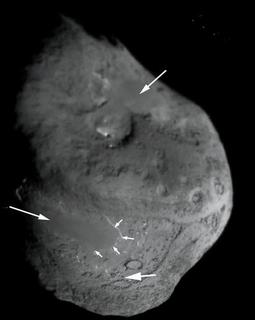
That's Right, You Heard The Man
Upon collision with Deep Impact, Tempel-1's contents revealed some very interesting substances. One of them was methyl cyanide, a chemical involed in the formation of DNA.
From the Christian Science Monitor (Perhaps a bit of Oxymoronic Irony there, no?) is this passage:
They have yet to identify all of the chemicals present in the material, which was ejected on July 4, when the comet collided with a projectile the Deep Impact spacecraft released.
But what they've seen so far makes it "more likely" that comets seeded Earth with the chemical precursors for organic life, says Michael A'Hearn, a University of Maryland planetary scientist and the mission's lead researcher.
Past studies from ground-based observatories and comet flybys have identified many of the chemicals in the halo of dust and gas that surrounds the core, as well as in the bright tails of comets.
But these sightings have had little to say directly about the amounts and relative abundance of the compounds comets contain in their cores.
As the team continues to pour through its data, researchers expect to identify all of the chemicals "that comets brought in abundance to the early Earth," Dr. A'Hearn says. "That will be our biggest contribution" to understanding comets' roles in the story of life on Earth.
One surprise: The team has detected an unexpectedly high concentration of methyl cyanide. Biologists say methyl cyanide is a key player in reactions that form DNA.
"If methyl cyanide is a particularly abundant component, it would suggest that comets could have delivered an abundance of these highly reactive compounds to the early Earth," notes Tom McCollom, a researcher at the University of Colorado at Boulder's Laboratory of Atmospheric and Space Physics.
Methyl cyanide's abundance may also confirm that comets like Tempel 1 can open a window on conditions from which the sun and solar system formed some 4.6 billion years ago.
In the dust and gas that inhabits the distances between stars, hydrogen cyanide is more abundant than methyl cyanide, notes Diane Wooden, an astrophysicist at the NASA Ames Research Center at Moffett Field, Calif.
But once frigid clouds of dust and gas begin to condense, methyl cyanide begins to dominate hydrogen cyanide in the center of the cloud where sun-like stars and planets will form.
Thus, Deep Impact may be looking at the heart of the cloud that gave birth to our solar system.
Deep Impact also has given planetary scientists the first direct measurements of a comet's density. The results imply that the nearly four-mile-wide nucleus is a loose ball of rubble. Global pictures of the nucleus suggest that it is built from two smaller sections that merged early in the object's history.
Moreover, when the impact struck, it burrowed into a layer of loosely bound, fine icy dust that is at least 30 feet deep. The surface appears to offer little support to anything that would land on it.
So in a roundabout way, Hoagland's ruminations about panspermia are being reinforced by the data that is coming out.
Oh yes, more notably, there are still no new photos or analyses. How'bout that, nudge-nudge-wink-wink?
Here's the same topic as covered by our fave popular science rag, 'New Scientist':

On 4 July, about 80 telescopes on Earth and in space trained their sights on Comet Tempel 1 when a 370-kilogram copper impactor was sent hurtling into its path. Just after the smash, a bright vapour plume spewed from the surface at about 5 kilometres per second, followed quickly by a stream of particles that spread into a cone.
The cone appeared to remain attached to the comet's surface for about 22 hours before separating into a detached arc. Researchers used this gravitational attraction to estimate the mass and density of the comet's main body, or nucleus. They found that the 72 trillion kilogram-nucleus was extremely porous, with as much as 80% of its volume taken up by empty space.
"That tells me there is no solid layer all the way down to the centre," says Mike A'Hearn, the mission's principal investigator at the University of Maryland in College Park, US. He says he had expected that the ice might become denser towards the core of the nucleus, but that instead "probably all the way in, ice is all in the form of tiny grains".
"It’s like a sponge, with a lot of cavities," agrees Horst Uwe Keller, an astronomer at the Max-Planck Institute for Solar System Research in Germany. He observed the event with Europe's Rosetta spacecraft and says the discovery confirms previous observations suggesting other comets are also porous. "When you touch it, it just crumbles under your hands."
Observers estimate the impact released about 5 million kilograms of water from beneath the comet's surface and between two and five times as much dust. There was so much dust, in fact, that mission members have not been able to see the impact crater with the high-resolution camera on the mission's flyby spacecraft, about 500 km away.
To add to the problem, that camera was malfunctioning but now image-processing techniques may have revealed a glimpse of the crater and team members may release the image later on Wednesday.
So there are images to come...
That ought to make things a lot more interesting.
BY THE WAY...
I'm off to NZ for 10 days. I may not have internet access during that time, in which case I won't be posting.
Just lettin' you all know so that you know why it's going to be quiet here. :)

No comments:
Post a Comment